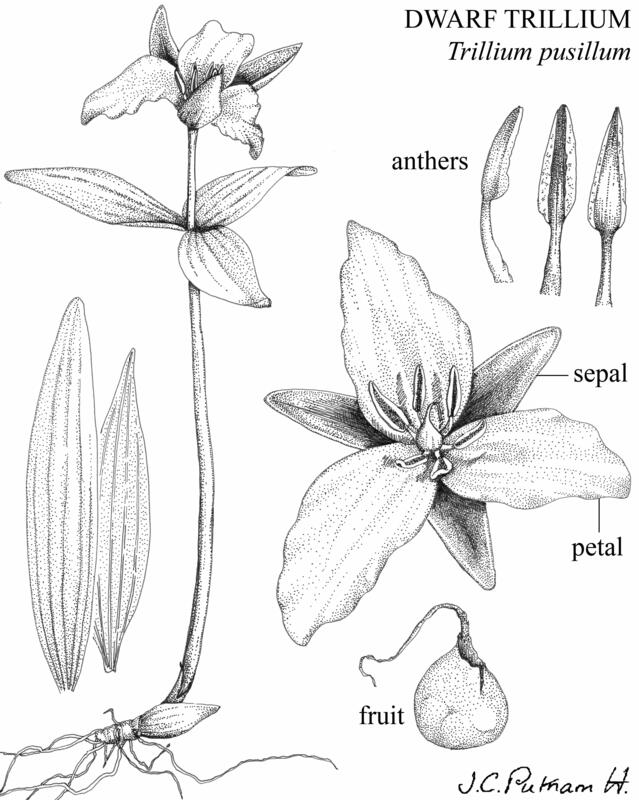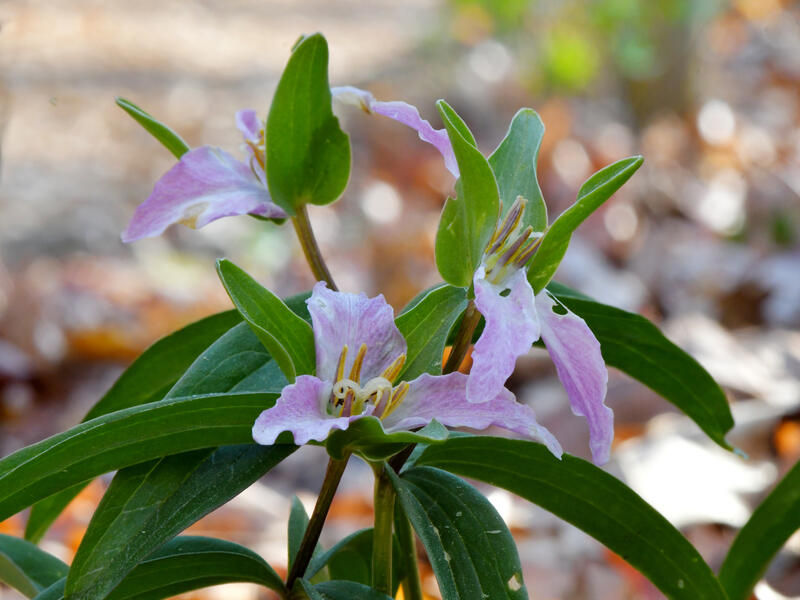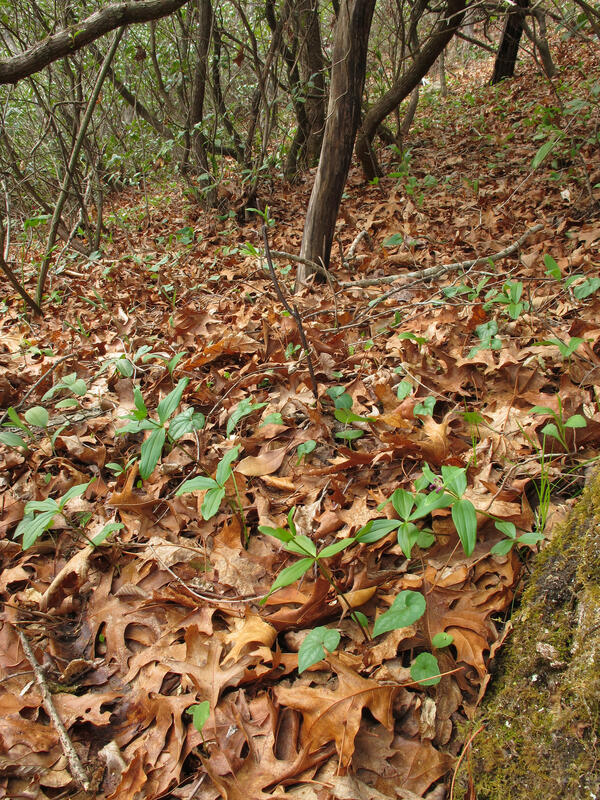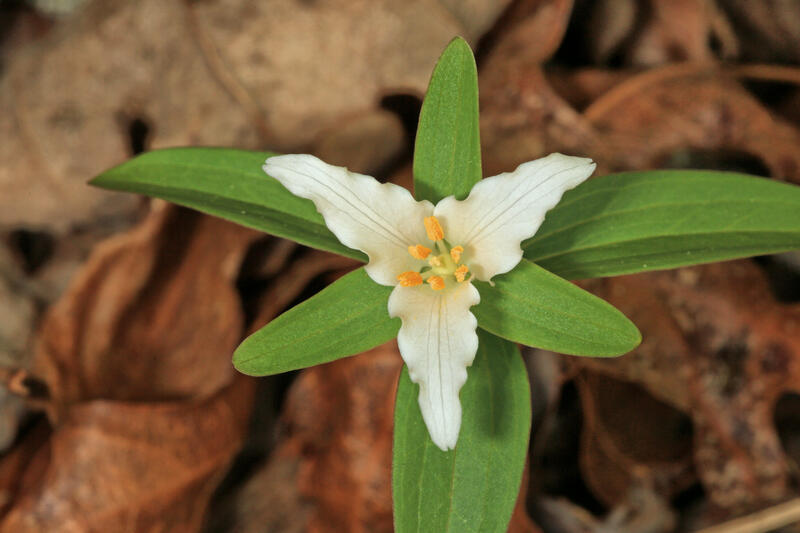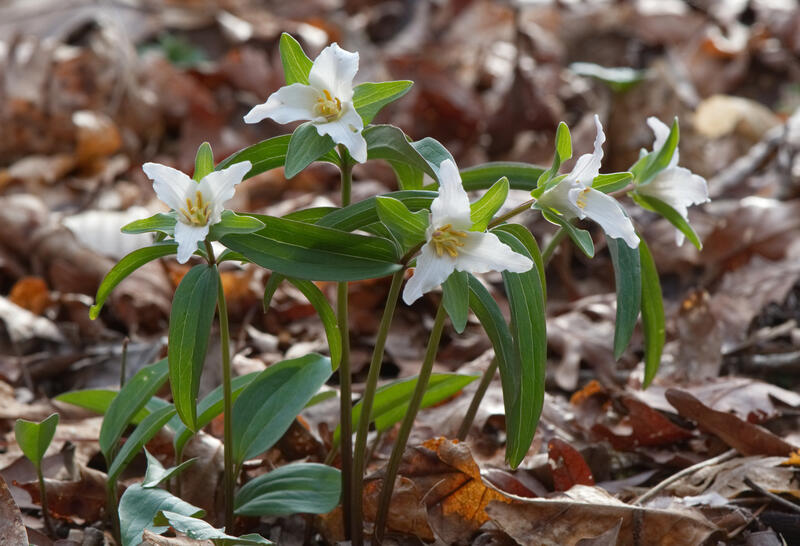

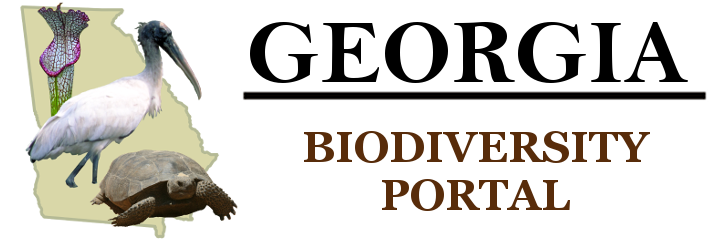





Loading profile. Please wait . . .
Trillium georgianum S.B. Farmer
Georgia Dwarf Trillium




Federal Protection: No US federal protection
State Protection: No Georgia state protection
Global Rank: G1
State Rank: S1
Element Locations Tracked in Biotics: Yes
SWAP 2015 Species of Greatest Conservation Need (SGCN): No
SWAP 2025 Species of Greatest Conservation Need (SGCN): Yes
2025 SGCN Priority Tier: Highest Conservation Concern
Element Occurrences (EOs) in Georgia: 3
Habitat Summary for element in Georgia: Perched calcarious hardwood flatwoods
Trillium georgianum (formerly Trillium pusillum var. georgianum) is a perennial herb with erect stems 3.9 - 5.4 inches (9.8 - 13.7 cm) tall rising from a rhizome. Leaves are usually 3 in number (one-leaved plants are also common), 1.4 - 2.2 inches (3.5 - 5.6 cm) long and 0.3 - 0.4 inches (0.7 - 1.1 cm) wide, lanceolate, 4 - 6 times longer than wide, in a whorl at the top of the stem; leaf stalks are absent or very short; the leaves have stomates on the upper surfaces, giving the leaves a mealy look (note: trillium leaves are called bracts in some treatments). A single flower is held on a leaning or erect stalk up to 1.3 inches (1.3 - 2.9 cm) long, rising from the center of the whorl of leaves. Sepals are 3 in number, about as wide as the petals with rounded tips, green with maroon undertones, held in the same plane as the petals. Petals are 3 in number, broadly oval, thin and delicate in texture with wavy edges and visible veins, 0.6 - 0.7 inch (1.5 - 1.9 cm) long, oval to lance-shaped, spreading or with downwardly curved tips, not overlapping at the base; white, turning pink with age. Stamens are 6 in number, with yellow anthers that open inward, greenish-white filaments, and pinkish-purple connectives. The ovary is green and faintly 6-angled, developing into a white or greenish, oval, fleshy capsule.
Persistent Trillium (T. persistens) is also a small, rare plant with similar flowers and leaves. It is known only from dry, upland, acidic sites in northeast Georgia. For more information, see: https://www.georgiabiodiversity.a2hosted.com/portal/profile?group=plants&es_id=19927
Large-flowered Trillium (T. grandiflorum) flowers also turn pink with age. It is a much larger plant, 8 - 20 inches (20 - 50 cm) tall, with large leaves up to 4.8 inches (12 cm) wide. For more information, see: http://beta.floranorthamerica.org/Trillium_grandiflorum
There are at least 24 species of Trillium in Georgia, 12 of which are rare:
Trillium decipiens (Mimic Trillium) occurs in moist hardwood forests and limesink forests in southwest Georgia. For more information, see: https://www.georgiabiodiversity.org/portal/profile?group=plants&es_id=20231
Trillium delicatum (Ocmulgee Trillium) occurs in central Georgia in moist to wet floodplain forests with high pH soils. For more information, see: https://www.georgiabiodiversity.org/portal/profile?group=plants&es_id=34971
Trillium discolor (Pale Yellow Trillium) occurs in moist hardwood forests only in the Savannah River watershed. For more information, see: https://www.georgiabiodiversity.org/portal/profile?group=plants&es_id=18320
Trillium flexipes (Bent Trillium) occurs in moist hardwood forests over limestone in northwest Georgia. For more information, see: http://beta.floranorthamerica.org/Trillium_flexipes
Trillium lancifolium (Lanceleaf Trillium) occurs in floodplain forests and lower slopes over basic soils in widely scattered locations in Georgia. For more information, see: http://beta.floranorthamerica.org/Trillium_lancifolium
Trillium persistens (Persistent Trillium, Edna's Trillium) occurs in mixed Pine-Hemlock-hardwood forests in ravines or along streams in northeast Georgia, often with rhododendrons or in lowbush blueberry thickets. For more information, see: https://www.georgiabiodiversity.org/portal/profile?group=plants&es_id=19927
Trillium pusillum (Dwarf Trillium) occurs in seasonally wet, red maple-blackgum-oak woods in calcium-rich, clay soils in northwest Georgia. For more information, see: https://www.georgiabiodiversity.org/portal/profile?group=plants&es_id=18756
Trillium reliquum (Relict Trillium) occurs in mature hardwood forests in rich ravines and on stream terraces, over calcium-rich bedrock such as amphibolite or limestone. For more information, see: https://www.georgiabiodiversity.org/portal/profile?group=plants&es_id=17442
Trillium simile (Sweet White Trillium) occurs in Georgia's Blue Ridge mountains in rich coves or slopes over mafic rocks, often in or near seepage. For more information, see: http://beta.floranorthamerica.org/Trillium_simile
Trillium sp. [newly recognized, unnamed species] (Lookout Mountain Toadshade) occurs in rich forests in northwest Georgia, southeast Tennessee, and northeast Alabama; it resembles Trillium ludovicianum.
Trillium sp. [newly recognized, unnamed species] (Amicalola Trillium) occurs in Blue Ridge cove forests in Georgia and South Carolina; it resembles Trillium simile.
Trillium sulcatum (Barksdale Trillium) occurs in rich, moist hardwood forests in northwest Georgia. For more information, see: http://beta.floranorthamerica.org/Trillium_sulcatum
Slightly elevated mounds in perched calcareous flatwoods, i.e. seasonally (winter and spring) wet swamps with calcium-rich, clay soils and a canopy of Red Maple, Swamp Black Gum, Shumard Oak, and Willow Oak.
Trillium georgianum reproduces sexually by seeds and also spreads by rhizome branching and forms clonal clusters of vegetative plants with only a few included flowering plants. All trilliums are perennial herbs that send up stems, leaves, and flowers in early spring, after temperatures have risen but before the forest canopy has leafed out. After flowering and fruiting, the aboveground plant disappears, persisting through the late summer, fall, and winter as an underground rhizome. Seeds shed in the summer germinate the following spring and, within a year or two, send up a single, spatula-shaped seed leaf (cotyledon) for one year’s growing season. The next year, a true leaf is produced and, in subsequent years, three-leaved plants appear. After 5 - 7 years (possibly fewer in the Coastal Plain), the plant produces a flowering stalk.
Trillium seeds have small, fat-rich appendages called elaiosomes that are appealing to ants, yellow jackets, and other wasps, which carry the seeds back to their nests, inadvertently dispersing the trillium seeds. Seeds are dispersed longer distances when the fruits are eaten by other animals such as deer and woodchucks. Some seeds are left where they fall if the elaiosomes are eaten off by beetles, resulting in clusters of seedlings near the parent plant. Trilliums such as Georgia Trillium produce clonal rhizome offshoots that develop into immature plants that are eventually separated from the parent plant as the rhizomes decay.
Mature trillium plants are very long-lived, perhaps living more than 100 years, but since the rhizome continues to lengthen and produce shoots on one end, while the other end decays, it is impossible to determine age from rhizome growth scars.
Surveys are best conducted during flowering (late March–early April).
Trillium georgianum is found only in northwest Georgia. It was previously considered a variety within the Trillium pusillum complex that includes varieties from throughout the southeastern U.S. Trillium georgianum is the only member of this complex that occurs in Georgia. For details of how Trillium georgianum warrants species-level recognition, see: Schilling et al. 2017, https://www.mapress.com/j/pt/article/view/phytotaxa.296.3.8/10235.
Logging and clearing in swamp forests and wet flatwoods. Ditching, draining, and filling in wetlands. Competition from exotic pest plants especially Japanese Honeysuckle.
| Threat 1 | Threat 2 | Threat 3 | |
|---|---|---|---|
| General Threat | Residential & commercial development | Natural system modifications | Transportation & service corridors |
| Specific Threat | None | None | None |
Approximately 2,000 plants occur in a single forest on private land in a rapidly developing industrial area.
Protect wetland forests from logging and clearing. Protect wetlands from ditching, draining, and development. Eradicate exotic pest plants. Use conservation funds to purchase the site where Trillium georgianum occurs or protect it with a conservation easement.
Case, F.W., Jr. 2003. Trillium pusillum species account. Flora of North America, Vol. 26. Oxford University Press, New York. http://beta.floranorthamerica.org/Trillium_pusillum
Broyles, B.B., S.M. Smith, T.R. Smith, and J.R. Kindt. 2013. A re-evaluation of the use of rhizome scars to age plants of Trillium erectum (Melanthiaceae). American Journal of Botany 100(6): 1155-1161. https://bsapubs.onlinelibrary.wiley.com/doi/abs/10.3732/ajb.1300022
Chafin, L.G. 2007. Field guide to the rare plants of Georgia. State Botanical Garden of Georgia and University of Georgia Press, Athens.
Farmer, S.B. 2007. A systematic study of Trillium subgenus Delostylis. Ph.D. Dissertation. University of Tennessee, Knoxville. https://trace.tennessee.edu/utk_graddiss/4235/
Farmer, S.B. 2006. Trillium and the Trillium family (Trilliaceae). http://www.goldsword.com/sfarmer/Trillium
Farmer, S.B. and E.E. Schilling. 2002. Phylogenetic analyses of Trilliaceae based on morphological and molecular data. Systematic Botany 27: 674-692. https://bioone.org/journals/systematic-botany/volume-27/issue-4/0363-6445-27.4.674/Phylogenetic-Analyses-of-Trilliaceae-based-on-Morphological-and-Molecular-Data/10.1043/0363-6445-27.4.674.short
GADNR. 2020. Element occurrence records for Trillium georgianum. Georgia Department of Natural Resources, Wildlife Resources Division, Social Circle, Georgia.
Kral, R. 1983. Trillium pusillum species account. A report on some rare, threatened, or endangered forest-related vascular plants of the South. Technical Publication R8-TP2. United States Forest Service, Atlanta.
NatureServe. 2020. Species account for Trillium georgianum. NatureServe Explorer. Arlington, Virginia. https://explorer.natureserve.org/Taxon/ELEMENT_GLOBAL.2.790964/Trillium_georgianum
Ohara, M. 1989. Life history evolution in the genus Trillium. Plant Species Biology 4:1-28. https://esj-journals.onlinelibrary.wiley.com/doi/epdf/10.1111/j.1442-1984.1989.tb00044.x
Patrick, T.S. 2007. Trilliums of Georgia. Tipularia, Journal of the Georgia Botanical Society 22: 3 - 22.
Patrick, T.S., J.R. Allison, and G.A. Krakow. 1995. Protected plants of Georgia. Georgia Department of Natural Resources, Wildlife Resources Division, Social Circle, Georgia.
Ranger, L.S. 1996. Georgia is tops in trilliums for sure with the discovery of Trillium pusillum. BotSoc News 69(3):1.
Schilling, E.E., A. Floden, J. Lampley, T.S. Patrick, and S.B. Farmer. 2017. A new species in Trillium subgen. Delostylium (Melanthiaceae, Parideae). Phytotaxa 296 (3): 287-291. https://www.mapress.com/j/pt/article/view/phytotaxa.296.3.8/10235
Vellend, M., J. Myers, S. Gardescu, and P. Marks. 2003. Dispersal of Trillium seeds by deer: implications for long-distance migration of forest herbs. Ecology 84(4):1067-1072. https://esajournals.onlinelibrary.wiley.com/doi/abs/10.1890/0012-9658(2003)084[1067:DOTSBD]2.0.CO;2
Weakley, A.S. 2015. Flora of the southern and mid-Atlantic States. University of North Carolina Herbarium, University of North Carolina, Chapel Hill. http://www.herbarium.unc.edu/flora.htm
Zettler, J. A., T. P. Spira, and A. A. Craig. 2001. Yellow Jackets (Vespula spp.) disperse Trillium spp. seeds in Eastern North America. American Midland Naturalist 146(2): 444-446. https://tinyurl.com/y9lppfu3
Linda G. Chafin
L. Chafin, Jan. 2009: original account.
K. Owers, Feb. 2010: added pictures.
L. Chafin, June 2020: updated original account.
